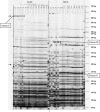Isolation of nontuberculous mycobacteria in Zambia: eight case reports
- PMID: 16333092
- PMCID: PMC1317173
- DOI: 10.1128/JCM.43.12.6020-6026.2005
Isolation of nontuberculous mycobacteria in Zambia: eight case reports
Abstract
The isolation of nontuberculous mycobacteria (NTM) raises the question of their clinical significance, especially in an African setting. We found a high percentage of NTM isolated from various specimens, including ones that are normally sterile, among 213 patients in Zambia. Because tuberculosis can affect all parts of the body, we decided to include patients who had signs and symptoms in any part of the body for more than 2 weeks. Most patients had tractus respiratorius (80%) and tractus digestivus (10%) symptoms. During three consecutive days, sputum was collected and two separate sputum specimens were cultured for mycobacteria. Depending on the clinical picture, pleural effusion, ascites, abscess material, or enlarged lymph nodes were also cultured for mycobacteria. A specimen from one sterile body site was collected from 25 patients (60% human immunodeficiency virus [HIV] positive). NTM were isolated from 8 of these 25 specimens. Mycobacterium lentiflavum was isolated from four patients, and Mycobacterium goodii was isolated from one patient. In order to exclude the possibility of laboratory cross-contamination, a novel amplified fragment length polymorphism DNA typing method for M. lentiflavum was developed. Genetic variation was detected, rendering the likelihood of laboratory contamination unlikely. Clinically relevant infection due to NTM occurs in both HIV-positive and HIV-negative patients in Zambia, and their clinical impact seems to be underestimated. This is the first report of M. lentiflavum and M. goodii infections in Africa.
Figures


References
-
- American Thoracic Society. 1997. Diagnosis and treatment of disease caused by nontuberculous mycobacteria. Am. J. Respir. Crit. Care Med. 156:S1-S25. - PubMed
-
- Ansari, N. A., A. H. Kombe, T. A. Kenyon, N. M. Hone, J. W. Tappero, S. T. Nyirenda, N. J. Binkin, and S. B. Lucas. 2002. Pathology and causes of death in a group of 128 predominantly HIV-positive patients in Botswana, 1997-1998. Int. J. Tuberc. Lung Dis. 6:55-63. - PubMed
-
- Brown, B. A., B. Springer, V. A. Steingrube, R. W. Wilson, G. E. Pfyffer, M. J. Garcia, M. C. Menendez, B. Rodriguez-Salgado, K. C. Jost, Jr., S. H. Chiu, G. O. Onyi, E. C. Bottger, and R. J. Wallace, Jr. 1999. Mycobacterium wolinskyi sp. nov. and Mycobacterium goodii sp. nov., two new rapidly growing species related to Mycobacterium smegmatis and associated with human wound infections: a cooperative study from the International Working Group on Mycobacterial Taxonomy. Int. J. Syst. Bacteriol. 49:1493-1511. - PubMed
-
- Buijtels P. C. A. M., and P. L. C. Petit. 2005. Comparison of NaOH-N-actetyl cysteine and sulphuric acid decontamination methods for recovery of mycobacteria from clinical specimens. J. Microbiol. Methods 62:83-88. - PubMed
-
- Cabria, F., M. V. Torres, J. I. Garcia-Cia, M. N. Dominguez-Garrido, J. Esteban, and M. S. Jimenez. 2002. Cervical lymphadenitis caused by Mycobacterium lentiflavum. Pediatr. Infect. Dis. J. 21:574-575. - PubMed
Publication types
MeSH terms
Substances
LinkOut - more resources
Full Text Sources
Medical

